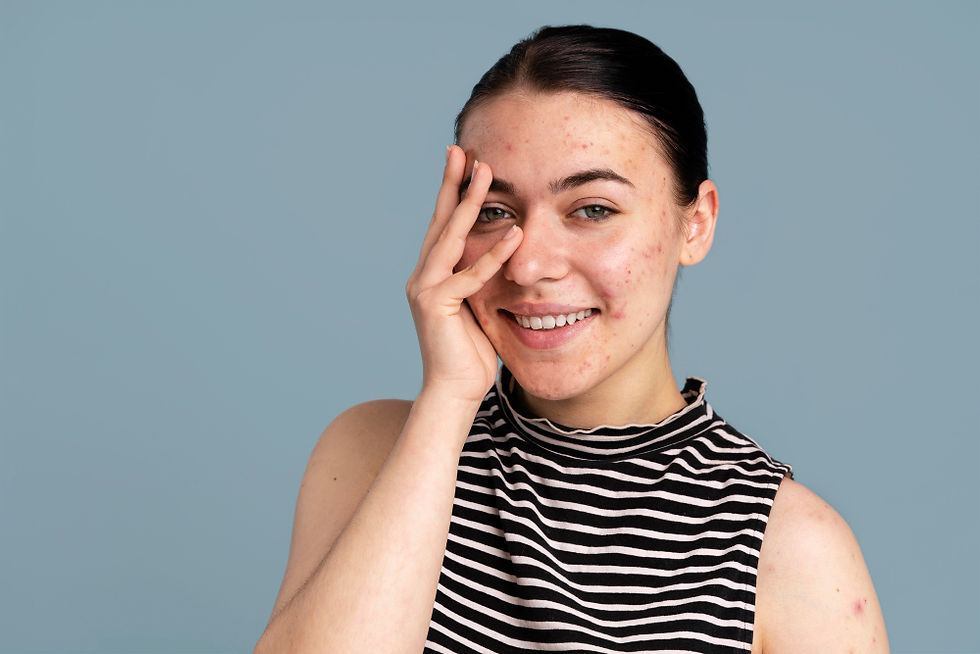Acne ABCs: When It Starts, Why It Happens, and What Actually Helps
- Skin IQ MedSpa

- Oct 25
- 7 min read
Updated: Nov 17

Acne does not define who you are; it simply reflects what your skin needs and how it reacts.
Acne is one of the most common skin concerns that affects both teens and adults, yet it remains one of the most misunderstood. Many people believe it comes from poor hygiene or oily skin, but that is far from true. Hormones, stress, diet, and even skin barrier imbalance can all play a role in acne causes and treatment.
Almost everyone experiences breakouts at some point in life. For some, it appears during teenage years, while others deal with acne in adults and teens well into later life. It looks and feels different for everyone, but one thing stays the same: it is normal and treatable. With the right understanding and patience, you can learn how to treat acne effectively.
At Skin IQ, we believe that clear skin begins with knowledge. Instead of quick fixes or harsh products, our goal is to offer real acne skincare education that helps you understand your skin’s behavior. This guide walks you through the truth behind acne, helping you make better choices for lasting, healthy skin.
Acne does not have to control your confidence. With the right care, understanding, and a little consistency, healthy and balanced skin is completely within your reach.
WHEN: When Does Acne Start – And Why Doesn’t It Always End?

There are certain things that cause the start of acne, and some other reasons that it keeps going. By reading below, you will get all the information you are looking for.
Teens (12–18)
Acne usually begins during puberty when hormones trigger excess oil production and changes in the skin’s natural balance. This increase in androgens makes oil glands more active, leading to clogged pores and inflammation. When does acne start? Most often, it appears on the forehead, nose, and chin as small bumps or painful spots. During these years, skin can easily react to stress, diet, and skincare habits, which can make acne worse or keep it from healing properly.
Early Adulthood (18–25)
For many, breakouts fade after teenage years, but for others, they continue or even get worse. Stress, lack of sleep, poor diet, and changes in hormones often keep the skin in a reactive state. Some adults experience acne when stopping or starting birth control, as hormone levels shift. Breakouts in this stage usually move toward the cheeks and jawline, sometimes showing deeper, cystic spots. Why acne does not go away for some people often comes down to genetics or an imbalanced skin barrier.
Late 20s to Early 40s
During this stage, hormonal acne in adults becomes more common, especially in women. Even with consistent care, hormonal shifts can cause unexpected breakouts.
Menstrual cycle changes can increase oil production.
Stopping or switching birth control affects hormone levels.
Pregnancy and postpartum periods bring major hormonal shifts.
Chronic stress raises cortisol, which triggers inflammation.
Conditions like PCOS or thyroid imbalance may contribute to adult acne causes.
Adult acne usually appears along the jawline, chin, and cheeks. It can be stubborn, but it is manageable with the right routine and lifestyle balance.
After 40
Although it is less common, acne after 40 is very real and often surprising for those who have never dealt with it before. Hormonal fluctuations related to perimenopause, medication changes, or years of using harsh skincare can disrupt the skin barrier. At this stage, acne may appear beside fine lines, uneven tone, and dryness. The skin becomes more sensitive, so gentle and consistent care is key. Treating adult acne in this phase means focusing on barrier repair and hydration while still targeting clogged pores effectively.
WHY: The Real Reasons Behind Acne

Many people often wonder why acne happens and what keeps it coming back. The truth is, it is not random or unlucky. By reading below, you will understand the real acne triggers and how they work together beneath the surface.
Excess Oil: When oil glands become overactive, they produce too much sebum. This extra oil mixes with dead skin cells, clogging the pores and creating the perfect environment for acne to form.
Clogged Pores: When pores are blocked by oil, dirt, or dead skin, they trap bacteria inside. This leads to bumps, blackheads, or painful pimples that can linger if the skin barrier is not healthy.
Bacteria Growth: The natural bacteria on your skin can multiply quickly inside clogged pores. This overgrowth triggers inflammation, redness, and swelling — the visible signs of an acne flare-up.
Hormonal Shifts: Changes in hormones, especially androgens, can increase oil production and make breakouts worse. This is why acne often appears during puberty, around menstrual cycles, or during times of stress.
Stress and Sleep: Stress raises cortisol levels, which increases oil production. Lack of proper sleep slows down skin repair, making acne last longer and heal more slowly.
Diet Choices: Foods high in sugar, dairy, or refined carbs can affect hormones and oil levels. For some people, this connection can lead to repeated breakouts.
Damaged Skin Barrier: Over-exfoliating, harsh products, or skipping moisture can weaken the skin barrier. When the barrier is damaged, irritation leads to inflammation — and that cycle fuels new acne.
Each of these factors plays a role in how acne forms and continues. Understanding what causes acne is the first step toward breaking the cycle and treating acne and hormones with a more balanced approach.
TYPES: Not All Acne Is the Same
Before choosing any skincare approach, it is important to understand what type of acne you are dealing with. Read below to see a clear breakdown that helps with proper acne identification.
Type of Acne | Description | Common Triggers |
Comedonal Acne | Small bumps like whiteheads and blackheads that stay close to the surface of the skin. | Excess oil, buildup of dead skin, and slow cell turnover. |
Inflammatory Acne | Red, swollen pimples that may feel sore or tender to the touch. | Bacteria, excess oil, and inflammation under the skin. |
Papules and Pustules | Papules are small red bumps, while pustules contain pus and appear more inflamed. | Overactive oil glands, clogged pores, and bacterial growth. |
Cystic Acne | Deep, painful lumps that form under the skin and may cause scarring. | Hormonal changes, genetics, and stress-related oil production. |
Hormonal Acne | Breakouts along the chin and jawline often appear around menstrual cycles. | Fluctuations in estrogen and progesterone levels. |
Fungal Acne (Folliculitis) | Itchy, small, uniform bumps are often found on the chest, back, or forehead. | Yeast overgrowth from sweat, humidity, or tight clothing. |
Each type behaves differently, so treatments that help one person might not work for another. Recognizing the types of acne and kinds of pimples helps you choose safer, more targeted solutions. For stubborn cystic vs hormonal acne, it is best to seek professional care and personalized advice.
WHAT TO DO: A Framework That Actually Works

There is no single way to fix acne, but a steady and balanced acne skincare routine can help the skin heal, strengthen, and stay clear over time.
1. Support The Barrier First
A strong skin barrier is the base of healthy skin. When it is damaged, even mild products can sting, dry, or worsen acne. Start by rebuilding it gently.
Simple steps to begin:
Gentle cleansing: Use a soft, non-foaming cleanser that removes oil and dirt without stripping your skin.
Light hydration: Pick a non-comedogenic moisturizer that locks in water and keeps your skin calm.
Daily SPF: Choose an oil-free sunscreen to protect against sun damage and barrier stress.
2. Introduce Proven Active Ingredients
Once your skin feels balanced, you can add ingredients that are proven to treat acne safely. Introduce one at a time and watch how your skin reacts.
Salicylic Acid: Helps unclog pores, smooth rough texture, and reduce buildup for clearer skin.
Benzoyl Peroxide: Targets bacteria and helps calm inflammation without overdrying when used in low strength.
Retinoids: Encourage faster skin renewal and reduce clogged pores, helping with both acne and post-breakout marks.
Azelaic Acid: Reduces redness, supports barrier health, and evens out tone for sensitive skin types.
Niacinamide: A gentle multitasker that controls oil, fades redness, and strengthens the barrier alongside actives.
3. Avoid Over-Exfoliating And Product Hopping
Using too many scrubs, acids, or new products too often can make your skin dry, sore, and more prone to breakouts. Keep things simple and consistent. A good acne skincare routine should focus on comfort, not quick results. Give your skin 8 to 12 weeks to respond before changing anything.
4. Do Not Skip Sunscreen
Skipping sunscreen can undo progress. Sun exposure can darken marks and increase irritation from active ingredients. Choose a sunscreen for acne-prone skin that feels light, oil-free, and blends easily into your morning routine. Using it daily helps your skin heal faster and stay even-toned.
5. Consider Professional Guidance
If acne does not improve or keeps returning, getting help from a skin professional can make a real difference.
Dermatologist visits: Get tailored care for your skin type and acne level.
In-office treatments: Options like chemical peels, LED light, or microneedling can speed up results.
Prescription options: A professional can suggest stronger treatments if needed.
Holistic guidance: They can help you adjust your skincare and lifestyle for better long-term control.
EMOTIONAL IMPACT: Acne Is More Than Skin Deep
Acne is not just about what appears on the surface. It can quietly affect how you feel about yourself, how you connect with others, and even how confident you feel in daily life. The emotional effects of acne are real and deserve the same care as the skin itself.
Many people experience acne confidence issues or start to hide behind makeup or isolation, thinking they are doing something wrong. But acne is not your fault. It is a skin condition that can happen to anyone, and it takes time and care to manage.
As your skin heals, your confidence will too. Practicing kindness toward yourself helps lower stress, which can also improve skin health. True acne emotional healing starts when you stop blaming yourself and start focusing on steady care and patience.
Remember, clear skin begins with a clear mindset. Treat your skin with compassion, and your acne and self-esteem will both begin to rebuild naturally.
Final Thoughts
Acne can feel overwhelming and unpredictable, but it is never permanent. With a consistent acne skincare routine that focuses on skin barrier repair for acne, balanced actives, and daily care, your skin can gradually recover its natural balance. Whether you are facing your first breakout or managing adult acne, the key is patience and understanding. Your skin deserves gentle care that looks deeper than appearance and supports lasting clarity from within.
Patience matters. Clarity is possible.
Healing takes time, but each step counts. Focus on what your skin truly needs and give it room to breathe. Explore more about tailored acne treatment steps and effective acne skincare routines in our next post, Skincare Products & Skin Secrets: Episode 1, where we uncover trusted products and tips designed to bring out your healthiest skin. Read more here.




Comments